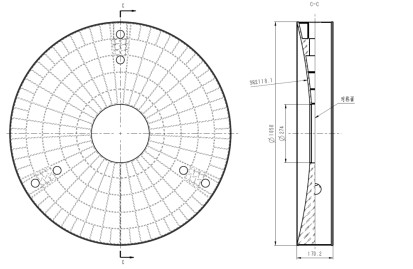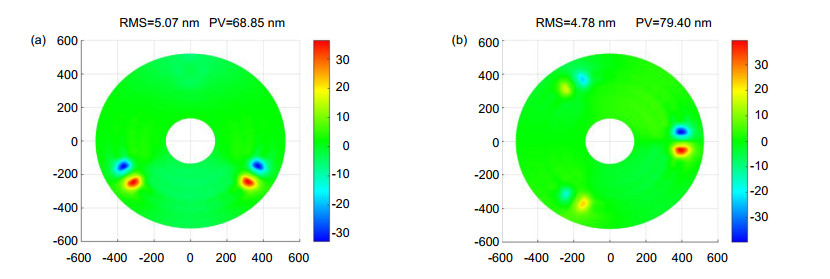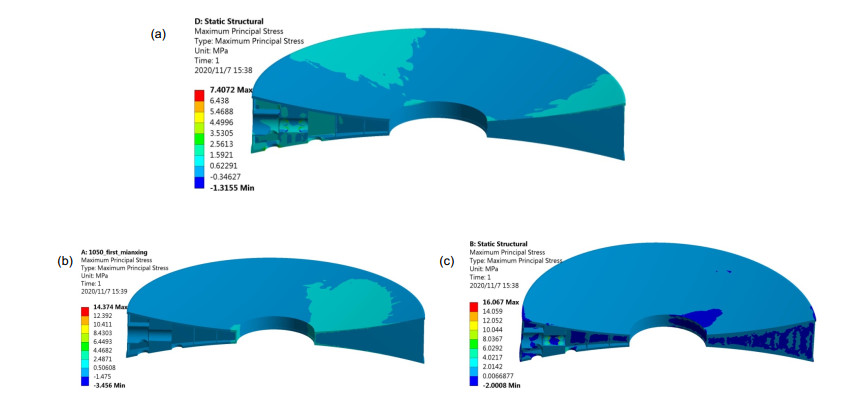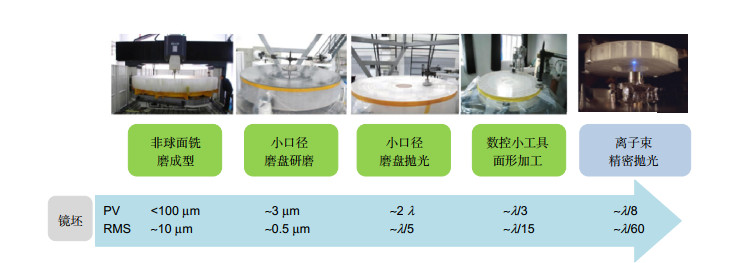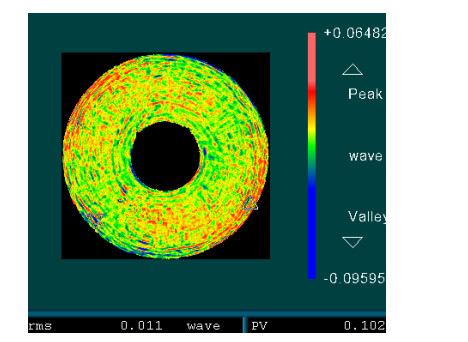-
摘要
针对Ф1.05 m空间光学系统主镜的设计指标要求,提出了轻量化反射镜结构优化设计的新方法,并建立了反射镜结构自动化仿真分析与优化设计平台,基于此平台确定了性能优异的主镜结构设计方案。主镜重量小于50 kg,轻量化率已接近国外先进水平; 主镜在三球铰支撑下的第一阶模态频率为361.2 Hz,自由状态下的一阶非零模态频率为501.9 Hz; 在1 ℃均匀温度变化下,不去离焦和去除离焦之后的面形RMS分别为0.55 nm和0.10 nm; 主镜在30g过载加速度作用下的最大应力为16.1 MPa,均满足设计要求。采用目前最先进的第三代大口径反射镜加工工艺,路线为超精密铣磨—小磨头数控研抛—离子束精修,实现主镜面形误差的确定性去除。为保证面形检测结果的天地一致性,发展了重力卸载技术和面形误差数据后处理技术,剔除重力和其他系统误差对检测的影响。主镜最终面形精度达到0.011λ RMS,获得了高精度的光学面形,也证明了方案的合理性。

Abstract
In terms of the strict design requirements of Ф1.05 m primary mirrors for space optical systems, a new method of structural optimization design of lightweight mirrors is proposed, and a platform for automatic simulation analysis and optimization design of mirror structures are established. The primary mirror design with excellent performances is determined based on that platform. The primary mirror weighs less than 50 kg, and the lightweight ratio is close to the foreign advanced level. The first mode frequency of the primary mirror under the support of three spherical hinges is 361.2 Hz, and the first-order non-zero free modal frequency is 501.9 Hz. Under the uniform temperature change of 1 ℃, the surface figures with defocus and without defocus are 0.55 nm RMS and 0.10 nm RMS, respectively. The maximum stress of the primary mirror under 30g overload acceleration is 16.1 MPa. All of these performances meet the design requirements. The most advanced third-generation large-aperture mirror processing technology is adopted, and the route is ultra-precision milling, CNC grinding and polishing of small grinding head, and ion beam finishing. In order to ensure the consistency of surface shape test results no matter in the space or on the ground, the gravity unloading technology, and surface shape error data post-processing technology are developed to eliminate the influence of gravity and other systematic errors. The final surface shape accuracy of the primary mirror reaches 0.011 λ RMS, which shows a high precision optical surface and demonstrates the rationality of the scheme.
-
Key words:
- space optical system /
- lightweight mirror /
- optimization design /
- optical processing
-
Overview

Overview: Ф 1 m magnitude space optical system has become the core strength in the field of domestic and overseas space observation. It has become one of the hotspots in the field of space optical system development in China because of its great demand and wide application prospect. Considering the launch cost, the space optical system should reduce the structural weight as much as possible. As the core component of the space optical system, the space mirror has a direct impact on the total weight of the system. Effectively reducing the weight of the reflector can greatly reduce the system's launch cost. Under the premise of ensuring the surface precision, the space mirror is developing towards low surface density. The lightweight of mirror has become an important research topic. Compared with developed countries, China lags behind in the field of space optical remote sensing technology. The lightweight mirrors which have been applied in orbit with space optical systems have relatively small aperture and low lightweight level.
In terms of the strict design requirements of Ф 1.05 m primary mirrors for space optical systems, a new method of structural optimization design of lightweight mirrors is proposed, and a platform for automatic simulation analysis and optimization design of mirror structures is established. The primary mirror design with excellent performances is determined based on that platform. The primary mirror weighs less than 50 kg, and the lightweight ratio is close to the foreign advanced level. The first mode frequency of the primary mirror under the support of three spherical hinges is 361.2 Hz, and the first-order non-zero free mode frequency is 501.9 Hz. Under the uniform temperature change of 1 ℃, the surface figures with defocus and without defocus are 0.55 nm RMS and 0.10 nm RMS, respectively. The maximum stress of the primary mirror under 30g overload acceleration is 16.1 MPa. All of these performances meet the design requirements. The most advanced third-generation large-aperture mirror processing technology is adopted, and the route is ultra-precision milling, CNC grinding and polishing of small grinding head, and ion beam finishing. In order to ensure the consistency of surface shape test results no matter in the space or on the ground, the gravity unloading technology and surface shape error data post-processing technology are developed to eliminate the influence of gravity and other systematic errors. The final surface shape accuracy of the primary mirror reaches 0.011 λ RMS, which shows a high precision optical surface and demonstrates the rationality of the scheme.
-

-
表 1 Φ1.05 m主镜轻量化结构方案
Table 1. Lightweight structure of the Φ1.05 m primary mirror
mm 外径 主镜高度 面板厚度 格板壁厚 内环厚度 外环厚度 1050 170.2 8 3~4 4 4 -
参考文献
[1] 张绍华, 徐大龙.美国商业遥感卫星的发展[J].测绘与空间地理信息, 2016, 39(12): 135-138. http://www.cqvip.com/QK/98140B/201612/670878870.html
Zhang S H, Xu D L. The development of commercial remote sensing satellites in the United States[J]. Geomatics & Spatial Information Technology, 2016, 39(12): 135-138. http://www.cqvip.com/QK/98140B/201612/670878870.html
[2] 朱仁璋, 丛云天, 王鸿芳, 等.全球高分光学星概述(一):美国和加拿大[J].航天器工程, 2015, 24(6): 85-106. http://d.wanfangdata.com.cn/Periodical/htqgc201506015
Zhu R Z, Cong Y T, Wang H F, et al. Global high-resolution optical satellite overview (1): USA and Canada[J]. Spacecraft Engineering, 2015, 24(6): 85-106. http://d.wanfangdata.com.cn/Periodical/htqgc201506015
[3] 范宁, 祖家国, 杨文涛, 等. WorldView系列卫星设计状态分析与启示[J].航天器环境工程, 2014, 31(3): 337-342. http://d.wanfangdata.com.cn/Periodical/htqhjgc201403020
Fan N, Zu J G, Yang W T, et al. The design of WorldView satellite and its demonstrative value[J]. Spacecraft Environment Engineering, 2014, 31(3): 337-342. http://d.wanfangdata.com.cn/Periodical/htqhjgc201403020
[4] Feinberg L D, Dean B H, Hayden W L, et al. Space telescope design considerations[J]. Optical Engineering, 2012, 51(1): 011006. doi: 10.1117/1.OE.51.1.011006
[5] Liu S T, Hu R, Li Q H, et al. Topology optimization-based lightweight primary mirror design of a large-aperture space telescope[J]. Applied Optics, 2014, 53(35): 8318-8325. doi: 10.1364/AO.53.008318
[6] Trumper I, Hallibert P, Arenberg J W, et al. Optics technology for large-aperture space telescopes: from fabrication to final acceptance tests[J]. Advances in Optics and Photonics, 2018, 10(3): 644-702. doi: 10.1364/AOP.10.000644
[7] Kihm H, Yang H S. Design optimization of a 1-m lightweight mirror for a space telescope[J]. Optical Engineering, 2013, 52(9): 091806. doi: 10.1117/1.OE.52.9.091806
[8] Werner D. WorldView-4's long road to launch about to pay off for DigitalGlobe[J]. Space News, 2016, 27(17): 21-22. http://smartsearch.nstl.gov.cn/paper_detail.html?id=dd023ba8d33ba5c8fcf2b20e2cb237d3
[9] Watarai H, Katayama H, Niwa T, et al. Development of the wide-swath and high-resolution optical imager onboard advanced optical satellite (ALOS-3)[J]. Proceedings of SPIE, 2019, 11180: 111801Q. http://www.researchgate.net/publication/334639499_Development_of_the_wide-swath_and_high-resolution_optical_imager_onboard_advanced_optical_satellite_ALOS-3
[10] Lee H, Hahn M. KOMPSAT-3 digital elevation model correction based on point-to-surface matching[J]. Remote Sensing, 2019, 11(20): 2340. doi: 10.3390/rs11202340
[11] 刘书田, 胡瑞, 周平, 等.基于筋板式基结构的大口径空间反射镜构型设计的拓扑优化方法[J].光学精密工程, 2013, 21(7): 1803-1810. http://www.cnki.com.cn/article/cjfdtotal-gxjm201307023.htm
Liu S T, Hu R, Zhou P, et al. Topologic optimization for configuration design of web-skin-type ground structure based large-aperture space mirror[J]. Optics and Precision Engineering, 2013, 21(7): 1803-1810. http://www.cnki.com.cn/article/cjfdtotal-gxjm201307023.htm
[12] Wu J F. Design of high-lightweight space mirror component based on automatic optimization[J]. Journal of Physics: Conference Series, 2020, 1605: 012023. doi: 10.1088/1742-6596/1605/1/012023
[13] 叶鹏程, 潘光, 高山.一种快速优化拉丁超立方试验设计方法[J].西北工业大学学报, 2019, 37(4): 714-723. http://www.cnki.com.cn/Article/CJFDTotal-XBGD201904010.htm
Ye P C, Pan G, Gao S. Sampling design method of fast optimal Latin hypercube[J]. Journal of Northwestern Polytechnical University, 2019, 37(4): 714-723. http://www.cnki.com.cn/Article/CJFDTotal-XBGD201904010.htm
[14] Lei D, Luo Y J, Wang Y Y, et al. Improved method of hybrid genetic algorithm[J]. Applied Mechanics and Materials, 2014, 556-562: 4014-4017. doi: 10.4028/www.scientific.net/AMM.556-562.4014
-
访问统计


 E-mail Alert
E-mail Alert RSS
RSS

 下载:
下载:
